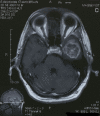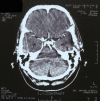Extracranial propagation of glioblastoma with extension to pterygomaxillar fossa
- PMID: 21595882
- PMCID: PMC3117736
- DOI: 10.1186/1477-7819-9-53
Extracranial propagation of glioblastoma with extension to pterygomaxillar fossa
Abstract
Background: Glioblastoma multiforme is a highly malignant primary brain tumor that shows marked local aggressiveness, but extracranial spread is not a common occurrence. We present an unusual case of recurrent glioblastoma in 54-year old male that spread through the scull base to the ethmoid and sphenoid sinuses, to the orbita, pterygomaxillar fossa, and to the neck.
Methods: A 54-year old male underwent left temporal resection because of brain tumor of his left temporal lobe. Operation was followed by external beam radiation combined with temozolomide. The tumor recurred eight months after first surgery. The patient developed swelling of left temporal region, difficult swallowing and headache. MRI of head showed recurrent tumor, which invaded orbita, ethmoid and sphenoid sinuses, nasal cavity, pterygomaxillar fossa.
Results: The patient died ten months after initial diagnosis of glioblastoma multiforme, and two months after his second operation.
Conclusions: The aggressive surgical operation helped to downsize the tumor mass as much as possible, but did not prolonged significantly the life or improved the life quality of the patient. The current literature is reviewed, and the diagnostic approaches as well as therapeutic options are discussed.
Figures







References
Publication types
MeSH terms
LinkOut - more resources
Full Text Sources
Medical

